Molecular Dynamics Modeling for the Determination of Elastic Moduli of Polymer–Single-Walled Carbon Nanotube Composites
Abstract
1. Introduction
2. Results and Discussion
2.1. Effect of Nanotube Concentration
2.1.1. Determination of Elastic Moduli for Polymer-SWCNT
2.1.2. Determination of Glass Transition Temperature for Polypropylene
2.2. Effect of Nanotube Size
2.3. Effect of Nanotube Types
3. Materials and Methods
4. Conclusions
Author Contributions
Funding
Institutional Review Board Statement
Informed Consent Statement
Data Availability Statement
Conflicts of Interest
References
- Iijima, S. Helical microtubules of graphitic carbon. Nature 1991, 354, 56–58. [Google Scholar] [CrossRef]
- Dresselhaus, M.S.; Dresselhaus, G.; Saito, R. Physics of carbon nanotubes. Carbon 1995, 33, 883–891. [Google Scholar] [CrossRef]
- Ruoff, R.S.; Lorents, D.C. Mechanical and thermal properties of carbon nanotubes. Carbon 1995, 33, 925–930. [Google Scholar] [CrossRef]
- Mintmire, J.W.; White, C.T. Electronic and structural properties of carbon nanotubes. Carbon 1995, 33, 893–902. [Google Scholar] [CrossRef]
- Collins, P.G.; Avouris, P. Nanotubes for Electronics. Sci. Am. 2000, 283, 62–69. Available online: http://www.jstor.org/stable/26058971 (accessed on 12 April 2023). [CrossRef]
- Chang, T.E.; Jensen, L.R.; Kisliuk, A.; Pipes, R.B.; Pyrz, R.; Sokolov, A.P. Microscopic mechanism of reinforcement in single-wall carbon nanotube/polypropylene nanocomposite. Polymer 2005, 46, 439–444. [Google Scholar] [CrossRef]
- Qian, D.; Dickey, E.C.; Andrews, R.; Rantell, T. Load transfer and deformation mechanisms in carbon nanotube-polystyrene composites. Appl. Phys. Lett. 2000, 76, 2868–2870. [Google Scholar] [CrossRef]
- Najipour, A.; Fattahi, A.M. Experimental study on mechanical properties of PE/CNT composites. JTAM 2017, 55, 719–726. [Google Scholar] [CrossRef]
- Banks-Sills, L.; Guy-Shiber, D.; Fourman, V.; Eliasi, R.; Shlayer, A. Experimental determination of mechanical properties of PMMA reinforced with functionalized CNTs. Compos. B Eng. 2016, 95, 335–345. [Google Scholar] [CrossRef]
- Hu, Z.; Arefin, M.R.H.; Yan, X.; Fan, Q.H. Mechanical property characterization of carbon nanotube modified polymeric nanocomposites by computer modeling. Compos. B Eng. 2014, 56, 100–108. [Google Scholar] [CrossRef]
- Arash, B.; Wang, Q.; Varadan, V.K. Mechanical properties of carbon nanotube/polymer composites. Sci. Rep. 2014, 4, 6479. [Google Scholar] [CrossRef] [PubMed]
- Sheikhnejad, O.; Nakamoto, T.; Kalteis, A.; Rajabtabar, A.; Major, Z. Molecular dynamic simulation of carbon nanotube reinforced nanocomposites: The effect of interface interaction on mechanical properties. MOJ Polym. Sci. 2018, 2, 6–10. [Google Scholar] [CrossRef]
- Han, Y.; Elliott, J. Molecular dynamics simulations of the elastic properties of polymer/carbon nanotube composites. Comput. Mater. Sci. 2007, 39, 315–323. [Google Scholar] [CrossRef]
- Lordi, V.; Yao, N. Molecular mechanics of binding in carbon-nanotube–polymer composites. J. Mater. Res. 2000, 15, 2770–2779. [Google Scholar] [CrossRef]
- Liao, K.; Li, S. Interfacial characteristics of a carbon nanotube–polystyrene composite system. Appl. Phys. Lett. 2001, 79, 4225–4227. [Google Scholar] [CrossRef]
- Meng, J.; Zhang, Y.; Cranford, S.W.; Minus, M.L. Nanotube Dispersion and Polymer Conformational Confinement in a Nanocomposite Fiber: A Joint Computational Experimental Study. J. Phys. Chem. B 2014, 118, 9476–9485. [Google Scholar] [CrossRef]
- Donchak, V.; Stetsyshyn, Y.; Bratychak, M.; Broza, G.; Harhay, K.; Stepina, N.; Kostenko, M.; Voronov, S. Nanoarchitectonics at surfaces using multifunctional initiators of surface-initiated radical polymerization for fabrication of the nanocomposites. Appl. Surf. Sci. 2021, 5, 100104. [Google Scholar] [CrossRef]
- Acierno, S.; Barretta, R.; Luciano, R.; Marotti de Sciarra, F.; Russo, P. Experimental evaluations and modeling of the tensile behavior of polypropylene/single-walled carbon nanotubes fibers. Compos. Struct. 2017, 174, 12–18. [Google Scholar] [CrossRef]
- Kravchenko, T.P.; Gorbunova, I.Y.; Filatov, S.N.; Kerber, M.L.; Rakov, E.G.; Kireev, V.V. Polypropylene-based nanostructured materials. Plast. Massy 2016, 43, 44–46. [Google Scholar] [CrossRef]
- Bao, S.P.; Tjong, S.C. Mechanical behaviors of polypropylene/carbon nanotube nanocomposites: The effects of loading rate and temperature. Mater. Sci. Eng. A 2008, 485, 508–516. [Google Scholar] [CrossRef]
- Sterzyński, T.; Tomaszewska, J.; Piszczek, K.; Skórczewska, K. The influence of carbon nanotubes on the PVC glass transition temperature. Compos. Sci. Technol. 2010, 70, 966–969. [Google Scholar] [CrossRef]
- Jiang, C.; Zhang, J.; Lin, S.; Ju, S.; Jiang, D. Effects of free organic groups in carbon nanotubes on glass transition temperature of epoxy matrix composites. Compos. Sci. Technol. 2015, 118, 269–275. [Google Scholar] [CrossRef]
- Wei, C.; Srivastava, D.; Cho, K. Thermal Expansion and Diffusion Coefficients of Carbon Nanotube-Polymer Composites. Nano Lett. 2002, 2, 647–650. [Google Scholar] [CrossRef]
- Singh, A.; Kumar, D. Effect of temperature on elastic properties of CNT-polyethylene nanocomposite and its interface using MD simulations. J. Mol. Model. 2018, 24, 178. [Google Scholar] [CrossRef] [PubMed]
- Lopez Manchado, M.A.; Valentini, L.; Biagiotti, J.; Kenny, J.M. Thermal and mechanical properties of single-walled carbon nanotubes–polypropylene composites prepared by melt processing. Carbon 2005, 43, 1499–1505. [Google Scholar] [CrossRef]
- Ngabonziza, Y.; Li, J.; Barry, C.F. Electrical conductivity and mechanical properties of multiwalled carbon nanotube-reinforced polypropylene nanocomposites. Acta Mech. 2011, 220, 289–298. [Google Scholar] [CrossRef]
- Coppola, B.; Di Maio, L.; Incarnato, L.; Tulliani, J.-M. Preparation and Characterization of Polypropylene/Carbon Nanotubes (PP/CNTs) Nanocomposites as Potential Strain Gauges for Structural Health Monitoring. Nanomaterials 2020, 10, 814. [Google Scholar] [CrossRef]
- Castillo, F.Y.; Socher, R.; Krause, B.; Headrick, R.; Grady, B.P.; Prada-Silvy, R.; Pötschke, P. Electrical, mechanical, and glass transition behavior of polycarbonate-based nanocomposites with different multi-walled carbon nanotubes. Polymer 2011, 52, 3835–3845. [Google Scholar] [CrossRef]
- Nam, T.H.; Goto, K.; Yamaguchi, Y.; Premalal, E.V.A.; Shimamura, Y.; Inoue, Y.; Naito, K.; Ogihara, S. Effects of CNT diameter on mechanical properties of aligned CNT sheets and composites. Compos. Part A Appl. Sci. Manuf. 2015, 76, 289–298. [Google Scholar] [CrossRef]
- Hegde, M.; Lafont, U.; Norder, B.; Picken, S.J.; Samulski, E.T.; Rubinstein, M.; Dingemans, T. SWCNT induced crystallization in an amorphous all-aromatic poly(ether imide). Macromolecules 2013, 46, 1492–1503. [Google Scholar] [CrossRef]
- Wang, X.; Jiang, Q.; Xu, W.; Cai, W.; Inoue, Y.; Zhu, Y. Effect of carbon nanotube length on thermal, electrical and mechanical properties of CNT/bismaleimide composites. Carbon 2013, 53, 145–152. [Google Scholar] [CrossRef]
- Malagù, M.; Goudarzi, M.; Lyulin, A.; Benvenuti, E.; Simone, A. Diameter-dependent elastic properties of carbon nanotube-polymer composites: Emergence of size effects from atomistic-scale simulations. Compos. Part B Eng. 2017, 131, 260–281. [Google Scholar] [CrossRef]
- WenXing, B.; ChangChun, Z.; WanZhao, C. Simulation of Young’s modulus of single-walled carbon nanotubes by molecular dynamics. Phys. B Condens. Matter 2004, 352, 156–163. [Google Scholar] [CrossRef]
- Eltaher, M.A.; El-Borgi, S.; Reddy, J.N. Nonlinear analysis of size-dependent and material-dependent nonlocal CNTs. Compos. Struct. 2016, 153, 902–913. [Google Scholar] [CrossRef]
- Aluko, O.; Gowtham, S.; Odegard, G.M. The assessment of carbon nanotube (CNT) geometry on the mechanical properties of epoxy nanocomposites. J. Micromechanics Mol. Phys. 2020, 5, 2050005. [Google Scholar] [CrossRef]
- Gupta, A.K.; Harsha, S.P. Analysis of mechanical properties of carbon nanotube reinforced polymer composites using multi-scale finite element modeling approach. Compos. Part B Eng. 2016, 95, 172–178. [Google Scholar] [CrossRef]
- Kumar, P.; Srinivas, J. Numerical evaluation of effective elastic properties of CNT-reinforced polymers for interphase effects. Comput. Mater. Sci. 2014, 88, 139–144. [Google Scholar] [CrossRef]
- MedeA, version 3.6; Materials Design, Inc.: San Diego, CA, USA.
- Plimpton, S.J. Fast parallel algorithms for short-range molecular dynamics. J. Comput. Phys. 1995, 117, 1–19. [Google Scholar] [CrossRef]
- Sun, H.; Mumby, S.J.; Maple, J.R.; Hagler, A.T. Ab Initio Calculations on Small Molecule Analogs of Polycarbonates. J. Phys. Chem. 1995, 99, 5873–5882. [Google Scholar] [CrossRef]
- Ewald, P. Evaluation of Optical and Electrostatic Lattice Potentials. Ann. Phys. 1921, 64, 253–287. [Google Scholar] [CrossRef]
- Berendsen, H.J.C.; Postma, J.P.M.; van Gunsteren, W.F.; Nola, A.D.; Haak, J.R. Molecular dynamics with coupling to an external bath. J. Chem. Phys. 1984, 81, 3684–3690. [Google Scholar] [CrossRef]
- Hestenes, M.R.; Stiefel, E. Methods of conjugate gradients for solving linear systems. J. Res. Natl. Bur. Stand. 1952, 49, 409–436. [Google Scholar] [CrossRef]
- Stiefel, E. Über einige Methoden der Relaxationsrechnung. ZAMP 1952, 3, 1–33. [Google Scholar] [CrossRef]
- Voigt, W. Lehrbuch Der Kristallphysik (Mit Ausschluss Der Kristalloptik); B.G. Teubner: Leipzig, Germany; Berlin, Germany, 1928. [Google Scholar]
- Reuss, A. Berechnung der fließgrenze von mischkristallen auf grund der plastizitätsbedingung für einkristalle. ZAMM 1929, 9, 49–58. [Google Scholar] [CrossRef]
- Hill, R. The elastic behaviour of a crystalline aggregate. Proc. Phys. Soc. A 1952, 65, 349–354. [Google Scholar] [CrossRef]
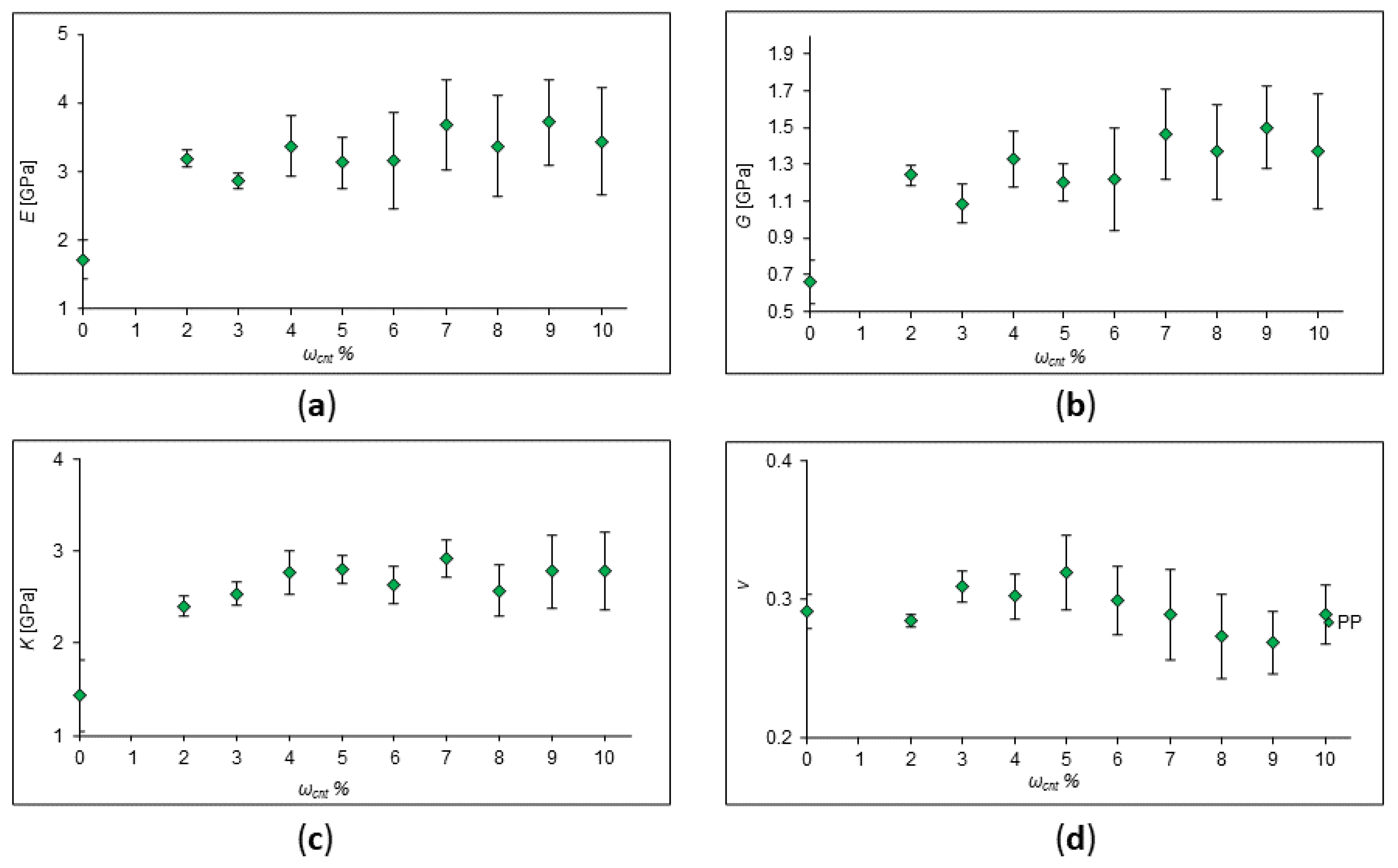
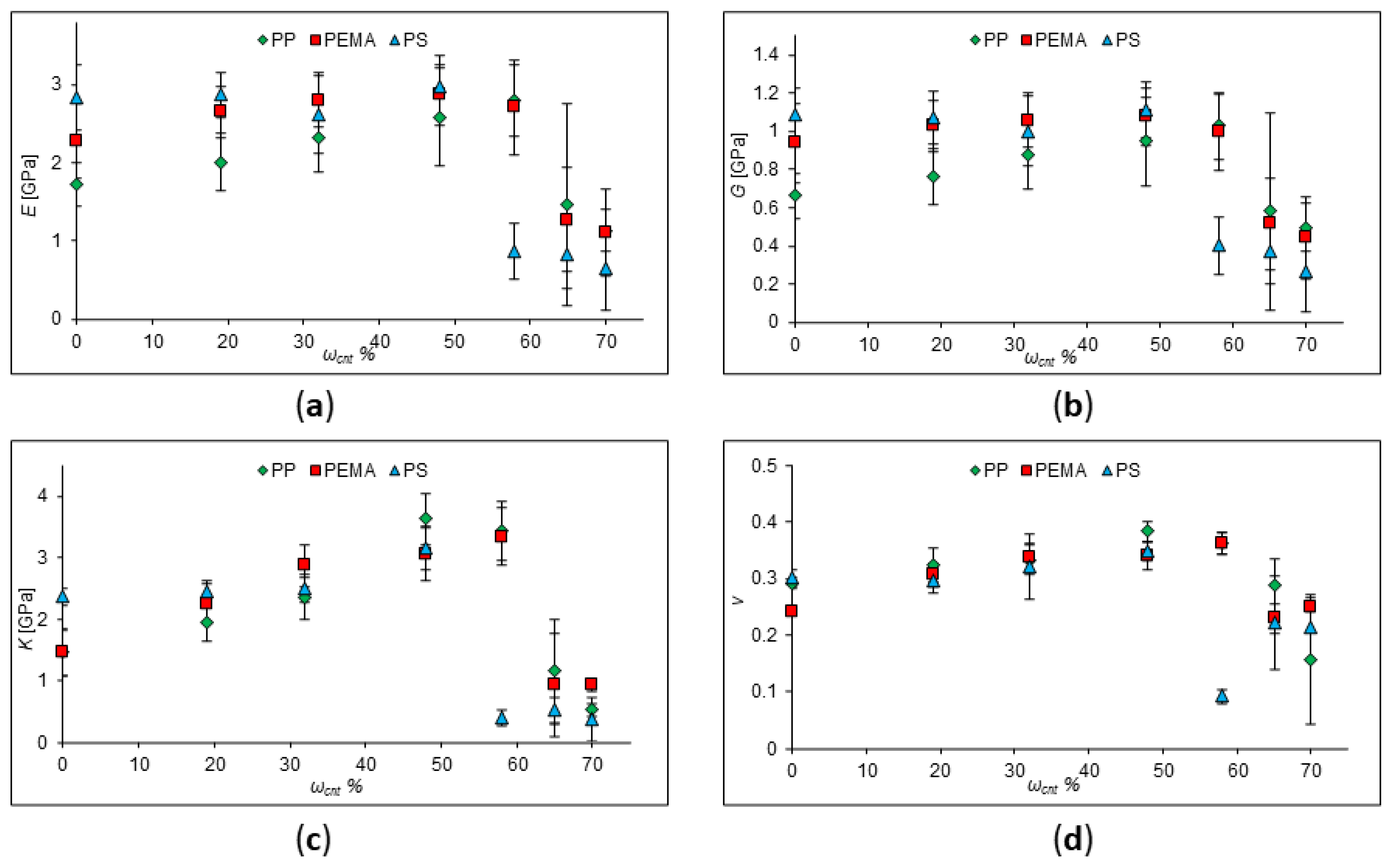
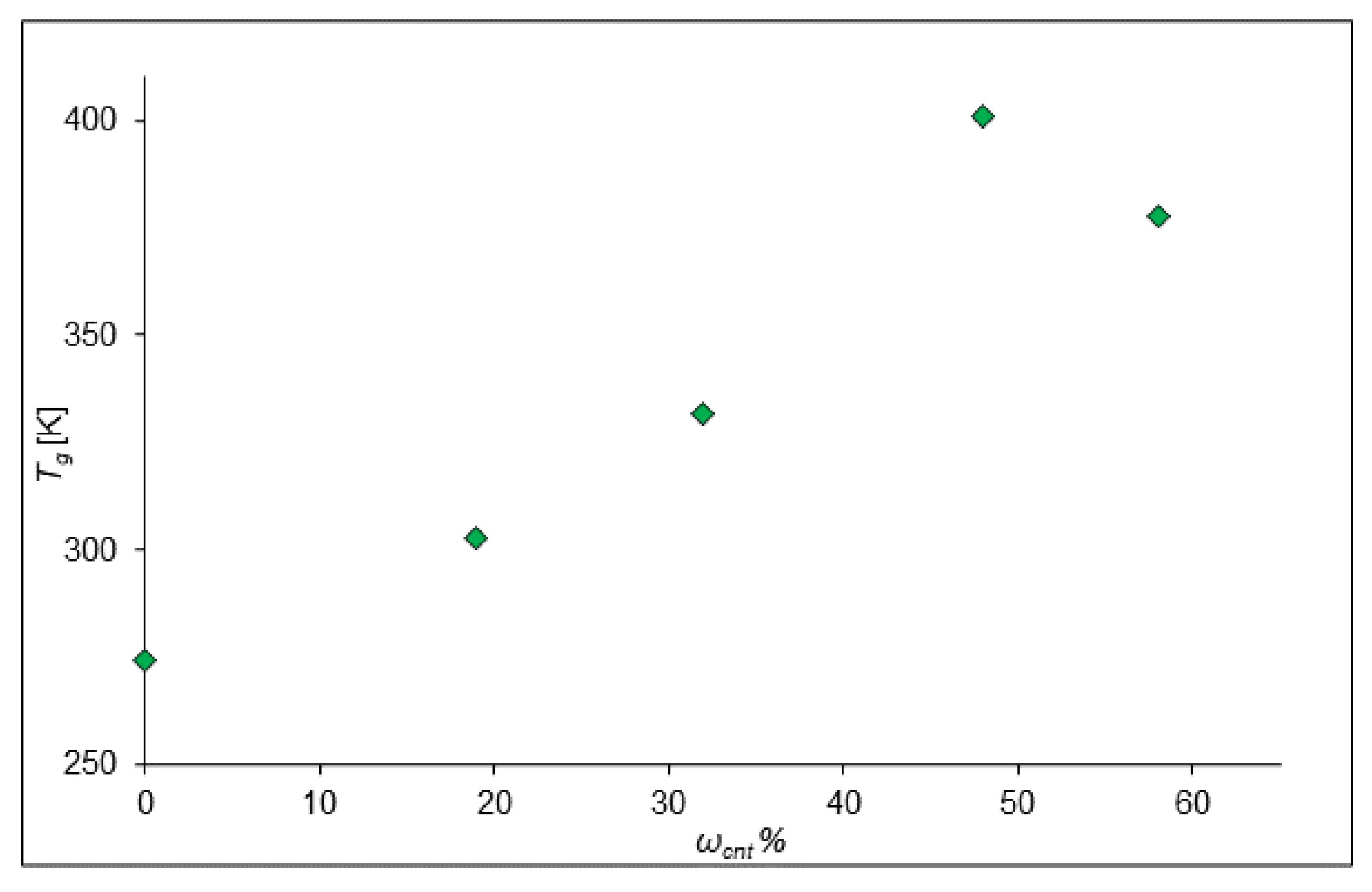


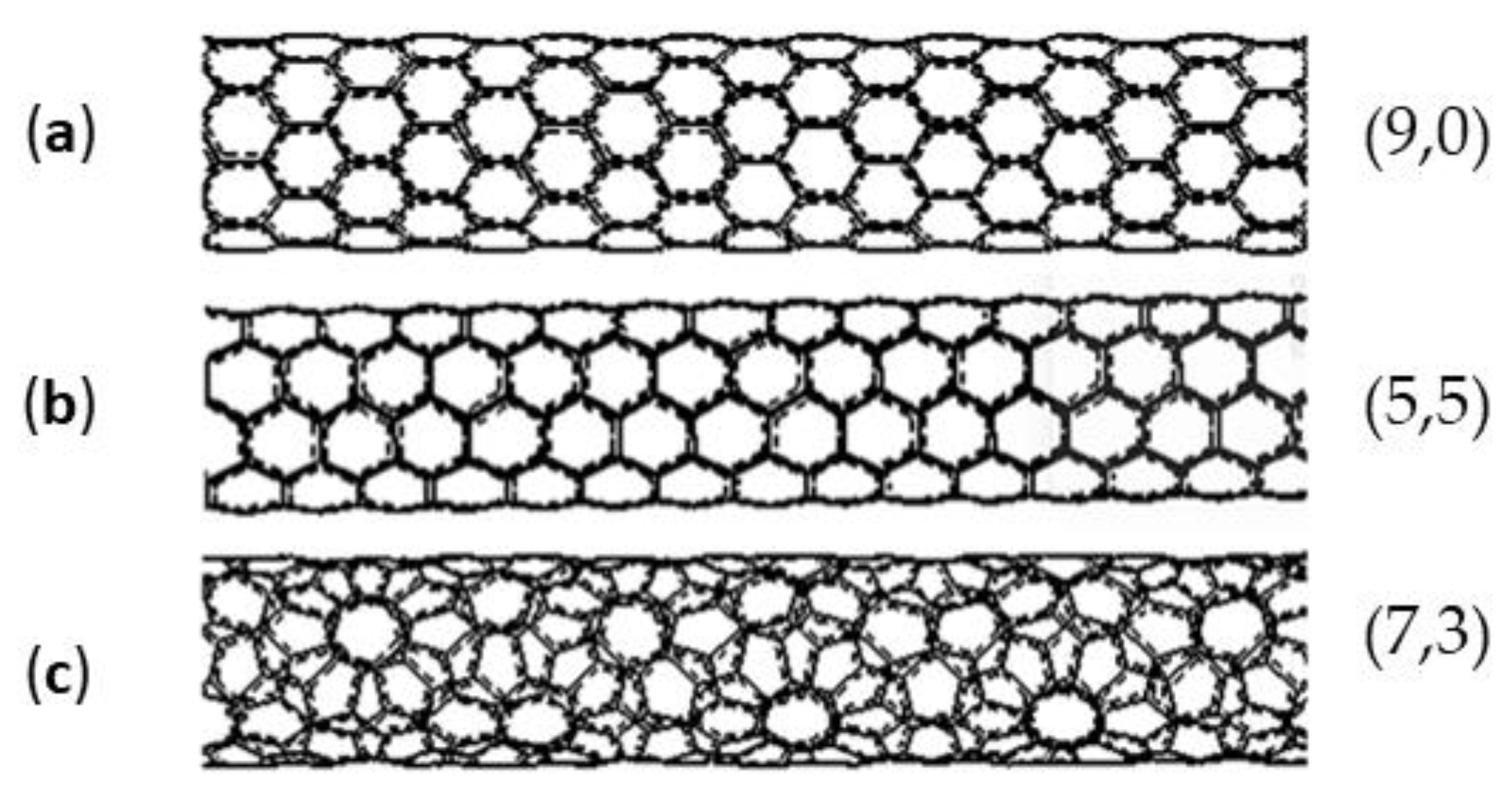

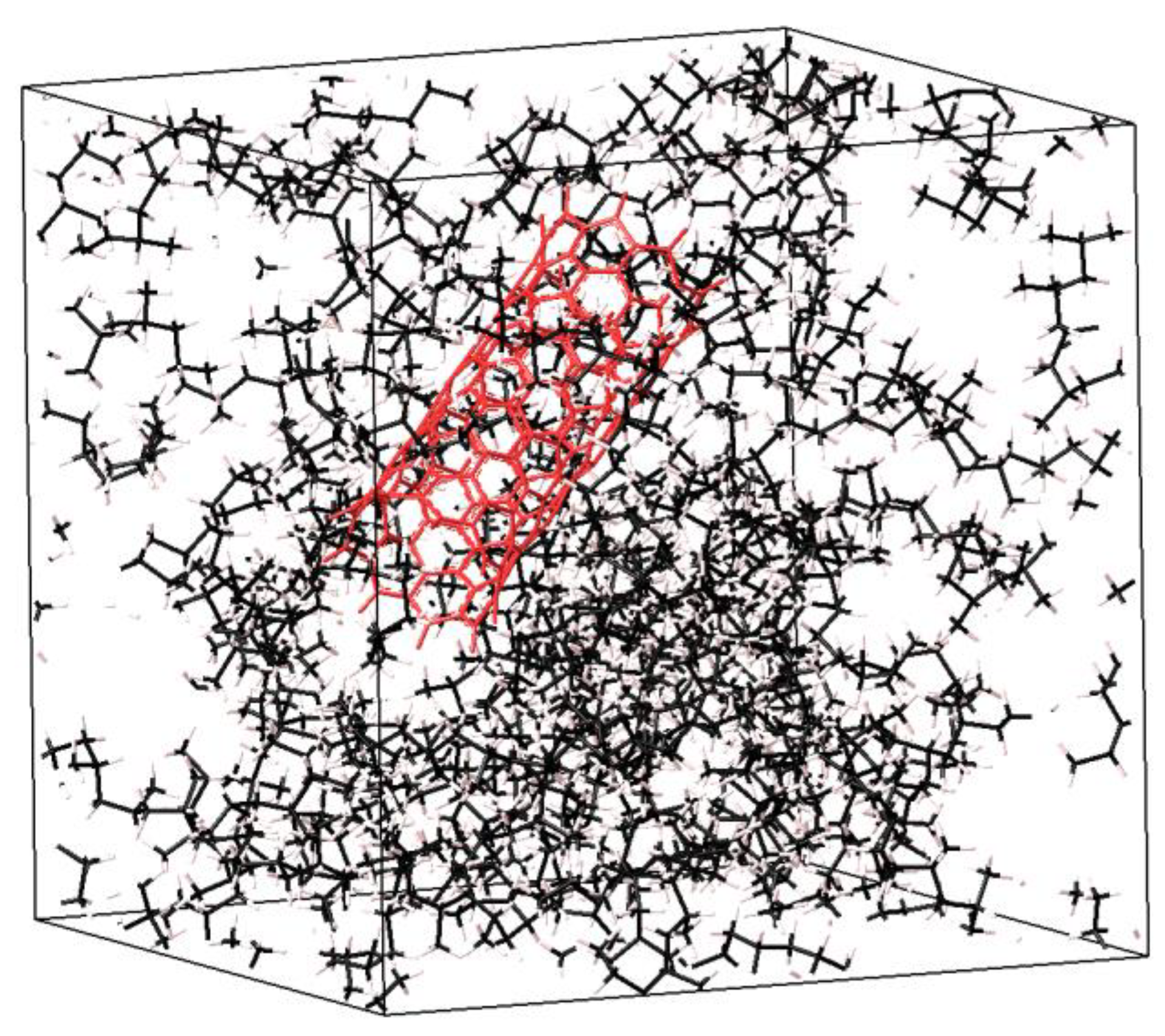
| SWCNT Concentration | Mn (g·mol−1) | N |
|---|---|---|
| pure | 4210 | 100 |
| 2% | 96,232 | 2287 |
| 3% | 63,500 | 1509 |
| 4% | 47,136 | 1120 |
| 5% | 37,315 | 887 |
| 6% | 30,768 | 731 |
| 7% | 26,092 | 620 |
| 8% | 22,585 | 537 |
| 9% | 19,857 | 472 |
| 10% | 17,675 | 420 |
| SWCNT Concentration | n | Mn (g·mol−1) of PP | N of PP | Mn (g·mol−1) of PEMA | N of PEMA | Mn (g·mol−1) of PS | N of PS |
|---|---|---|---|---|---|---|---|
| pure | 0 | 4210 | 100 | 4225 | 37 | 4168 | 40 |
| 19% | 1 | 8420 | 200 | 8450 | 74 | 8336 | 80 |
| 32% | 1 | 4210 | 100 | 4225 | 37 | 4168 | 40 |
| 48% | 2 | 4210 | 100 | 4225 | 37 | 4168 | 40 |
| 58% | 3 | 4210 | 100 | 4225 | 37 | 4168 | 40 |
| 65% | 4 | 4210 | 100 | 4225 | 37 | 4168 | 40 |
| 70% | 5 | 4210 | 100 | 4225 | 37 | 4168 | 40 |
| SWCNT Diameter, (Å) | (n,m) | l, (Å) | Mn (g·mol−1) | N |
|---|---|---|---|---|
| - | - | - | 4210 | 100 |
| 4.7 | (6,0) | 12 | 16,661 | 396 |
| 5.5 | (7,0) | 14 | 22,633 | 538 |
| 6.3 | (8,0) | 16 | 29,517 | 702 |
| 7.1 | (9,0) | 18 | 37,314 | 887 |
| 7.8 | (10,0) | 20 | 46,025 | 1094 |
| 8.6 | (11,0) | 22 | 55,648 | 1323 |
| SWCNT Diameter, [Å] | (n,m) | l, [Å] | Mn [g·mol−1] of PP | N of PP | Mn [g·mol−1] of PEMA | N of PEMA |
|---|---|---|---|---|---|---|
| - | - | - | 4210 | 100 | 4225 | 37 |
| 7.1 | (9,0) | 18 | 4210 | 100 | 4225 | 37 |
| 9.4 | (12,0) | 18 | 4210 | 100 | 4225 | 37 |
| 11.8 | (15,0) | 18 | 4210 | 100 | 4225 | 37 |
| 14.1 | (18,0) | 18 | 4210 | 100 | 4225 | 37 |
| 16.4 | (21,0) | 18 | 4210 | 100 | 4225 | 37 |
Disclaimer/Publisher’s Note: The statements, opinions and data contained in all publications are solely those of the individual author(s) and contributor(s) and not of MDPI and/or the editor(s). MDPI and/or the editor(s) disclaim responsibility for any injury to people or property resulting from any ideas, methods, instructions or products referred to in the content. |
© 2023 by the authors. Licensee MDPI, Basel, Switzerland. This article is an open access article distributed under the terms and conditions of the Creative Commons Attribution (CC BY) license (https://creativecommons.org/licenses/by/4.0/).
Share and Cite
Shamsieva, A.; Evseev, A.; Piyanzina, I.; Nedopekin, O.; Tayurskii, D. Molecular Dynamics Modeling for the Determination of Elastic Moduli of Polymer–Single-Walled Carbon Nanotube Composites. Int. J. Mol. Sci. 2023, 24, 11807. https://doi.org/10.3390/ijms241411807
Shamsieva A, Evseev A, Piyanzina I, Nedopekin O, Tayurskii D. Molecular Dynamics Modeling for the Determination of Elastic Moduli of Polymer–Single-Walled Carbon Nanotube Composites. International Journal of Molecular Sciences. 2023; 24(14):11807. https://doi.org/10.3390/ijms241411807
Chicago/Turabian StyleShamsieva, Aigul, Alexander Evseev, Irina Piyanzina, Oleg Nedopekin, and Dmitrii Tayurskii. 2023. "Molecular Dynamics Modeling for the Determination of Elastic Moduli of Polymer–Single-Walled Carbon Nanotube Composites" International Journal of Molecular Sciences 24, no. 14: 11807. https://doi.org/10.3390/ijms241411807
APA StyleShamsieva, A., Evseev, A., Piyanzina, I., Nedopekin, O., & Tayurskii, D. (2023). Molecular Dynamics Modeling for the Determination of Elastic Moduli of Polymer–Single-Walled Carbon Nanotube Composites. International Journal of Molecular Sciences, 24(14), 11807. https://doi.org/10.3390/ijms241411807







